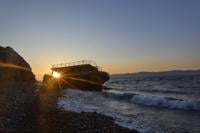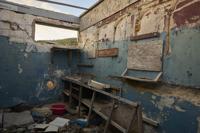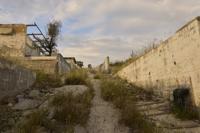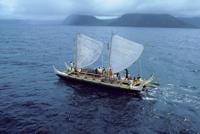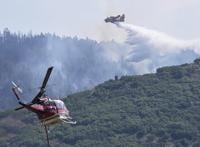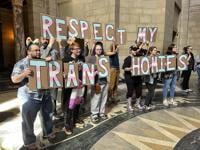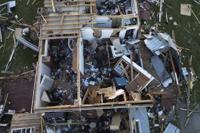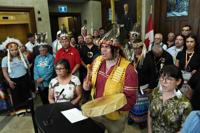LESBOS, Greece (AP) — LESBOS, Greece (AP) Fleeing Iran with her husband and toddler, Amena Namjoyan reached a rocky beach of this eastern Greek island along with hundreds of thousands of others. For months, their arrival overwhelmed Lesbos. Boats fell apart, fishermen dove to save people from drowning, and local grandmothers bottle-fed newly arrived babies.
Namjoyan spent months in an overcrowded camp. She learned Greek. She struggled with illness and depression as her marriage collapsed. She tried to make a fresh start in Germany but eventually returned to Lesbos, the island that first embraced her. Today, she works at a restaurant, preparing Iranian dishes that locals devour, even if they struggle to pronounce the names. Her second child tells her, “‘I’m Greek.’”
“Greece is close to my culture, and I feel good here,” Namjoyan said. “I am proud of myself.”
more than 1 million migrants and refugees arrived in Europe — the majority by sea, landing in Lesbos, where the north shore is just 10 kilometers (6 miles) . The influx of men, women and children fleeing war and poverty sparked a humanitarian crisis that shook the European Union to its core. A decade later, the fallout still reverberates on the island and beyond.
For many, Greece was a place of transit. They continued on to northern and western Europe. Many who applied for asylum were granted international protection; thousands . Countless more were rejected, languishing for years in migrant camps or living in the streets. Some returned to their home countries. Others were kicked out of the European Union.
For Namjoyan, Lesbos is a welcoming place — many islanders share a refugee ancestry, and it helps that she speaks their language. But migration policy in Greece, like much of Europe, has shifted toward deterrence in the decade since the crisis. Far fewer people are arriving illegally. Officials and politicians have maintained that strong borders are needed.Critics say enforcement has gone too far and violates fundamental EU rights and values.
“Migration is now at the top of the political agenda, which it didn’t use to be before 2015,” said Camille Le Coz Director of the Migration Policy Institute Europe, noting changing EU alliances. “We are seeing a shift toward the right of the political spectrum.”
A humanitarian crisis turned into a political one
In 2015, boat after boat crowded with refugees crashed onto the doorstep of Elpiniki Laoumi, who runs a fish tavern across from a Lesbos beach. She fed them, gave them water, made meals for aid organizations.
“You would look at them and think of them as your own children,” said Laoumi, whose tavern walls today are decorated with thank-you notes.
From 2015 to 2016, the peak of the migration crisis, more than 1 million people entered Europe through Greece alone. The immediate humanitarian crisis — to feed, shelter and care for so many people at once — grew into a long-term political one.
Greece was reeling from a crippling economic crisis. The influx added to anger against established political parties, fueling the rise of once-fringe populist forces.
EU nations fought over sharing responsibility for asylum seekers. The bloc’s unity cracked as some member states flatly refused to take migrants. Anti-migration voices calling for closed borders became louder.
Today, illegal migration is down across Europe
While illegal migration to Greece has fluctuated, numbers are nowhere near 2015-16 figures, according to the International Organization for Migration. Smugglers adapted to heightened surveillance, shifting to .
Overall, decreased by nearly 40% last year and continue to fall, according to EU border and coast guard agency Frontex.
That hasn’t stopped politicians from focusing on — and sometimes fearmongering over — migration. This month, the Dutch government after a withdrew his party’s ministers over migration policy.
In Greece, the new far-right has threatened rejected asylum seekers with .
A few miles from where Namjoyan now lives, in a forest of pine and olive trees, is a new EU-funded migrant center. It’s one of the largest in Greece and can house up to 5,000 people.
Greek officials denied an Associated Press request to visit. Its opening is blocked, for now, by court challenges.
Some locals say the remote location seems deliberate — to keep migrants out of sight and out of mind.
“We don’t believe such massive facilities are needed here. And the location is the worst possible – deep inside a forest,” said Panagiotis Christofas, mayor of Lesbos’ capital, Mytilene. “We’re against it, and I believe that’s the prevailing sentiment in our community.”
The legacy of Lesbos
Last year, EU nations approved a laying out common rules for the bloc’s 27 countries on screening, asylum, detention and deportation of people trying to enter without authorization, among other things.
“The Lesbos crisis of 2015 was, in a way, the birth certificate of the ,” Margaritis Schinas, a former European Commission vice president and a chief pact architect, told AP.
He said that after years of fruitless negotiations, he’s proud of the landmark compromise.
“We didn’t have a system,” Schinas said. “Europe’s gates had been crashed.”
The deal, endorsed by the United Nations refugee agency, takes effect next year. Critics say it made concessions to hardliners.Human rights organizations say it will increase detention and erode the right to seek asylum.
Some organizations also criticize the “externalization” of EU border management — agreements with countries across the Mediterranean to aggressively patrol their coasts and hold migrants back in exchange for financial assistance.
The deals have expanded, from to the and . Human rights groups say autocratic governments are pocketing billions and often subject the displaced to .
Lesbos still sees some migrants arrive
Lesbos’ 80,000 residents look back at the 2015 crisis with mixed feelings.
Fisherman Stratos Valamios saved some children. Others drowned just beyond his reach, their bodies still warm as he carried them to shore.
“What’s changed from back then to now, 10 years on? Nothing,” he said. “What I feel is anger — that such things can happen, that babies can drown.”
Those who died crossing to Lesbos are buried in two cemeteries, their graves marked as “unknown.”
Tiny shoes and empty juice boxes with faded Turkish labels can still be found on the northern coast. So can black doughnut-shaped inner tubes, given by smugglers as crude life preservers for children. At , a refugee camp destroyed by fire in 2020, children’s drawings remain on gutted building walls.
Migrants still arrive, , on these shores. Lesbos began to adapt to a quieter, more measured flow of newcomers.
Efi Latsoudi, who runs a network helping migrants learn Greek and find jobs, hopes Lesbos’ tradition of helping outsiders in need will outlast national policies.
“The way things are developing, it’s not friendly for newcomers to integrate into Greek society,” Latsoudi said. “We need to do something. ... I believe there is hope.”
___
This is a documentary photo story curated by AP photo editors.
Text from AP news story, , by Derek Gatopoulos, Lefteris Pitarakis and Renata Brito.


